Hassani S. Mathematical Physics: A Modern Introduction to Its Foundations
Подождите немного. Документ загружается.

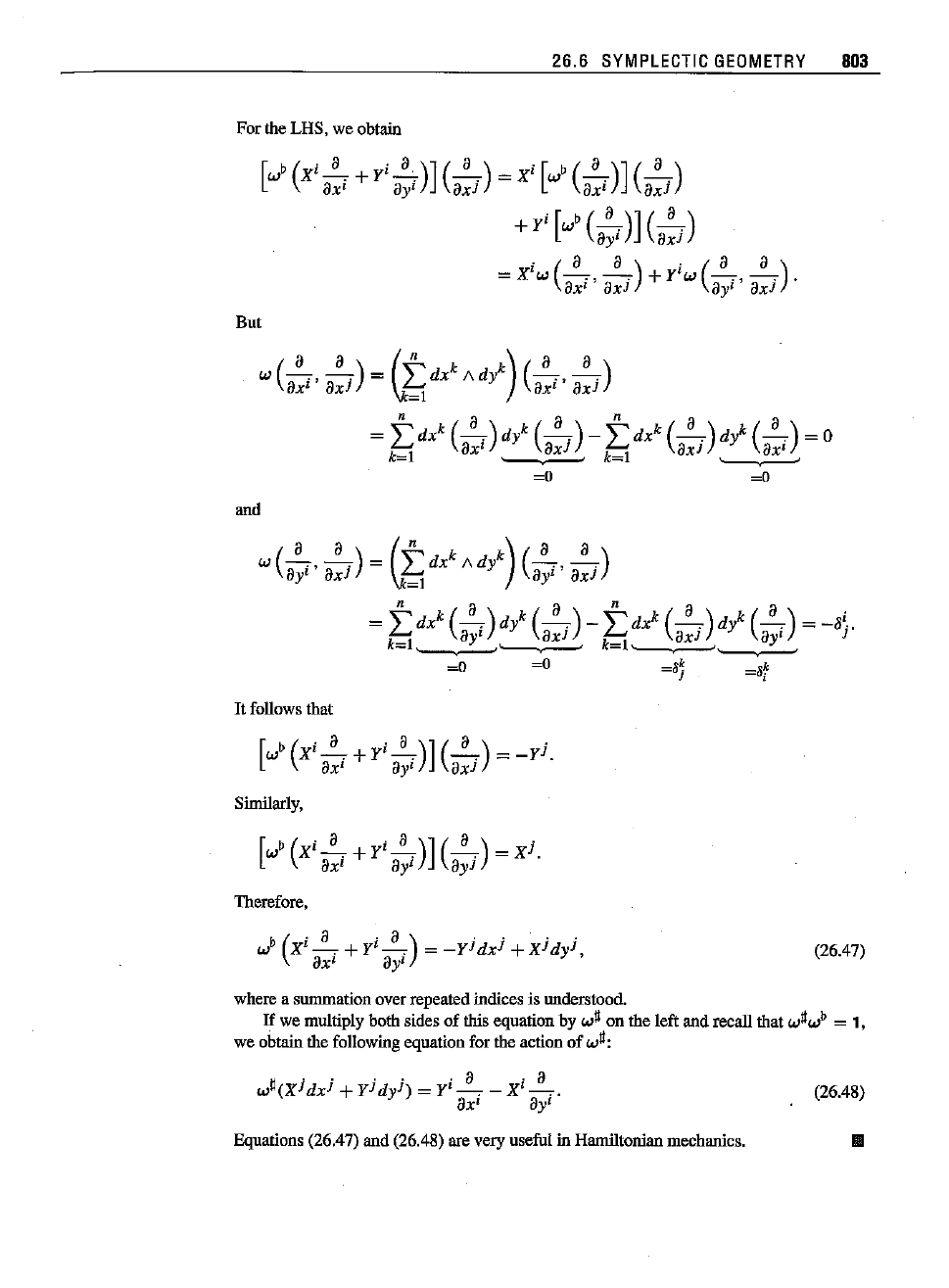
26.6
SYMPLECTIC
GEOMETRY
803
For the LHS, we obtain
But
and
It
follows that
[
,(
. a . a )] ( a ) .
w
X'-.
+yl_.
_.
=_yJ.
ox
'
oy'
ax)
Similarly,
Therefore,
(26.47)
where
a
summation
over
repeated
indices
is
understood.
If
we multiply both sides of this equation by w
U
ou the left and recall that wUw' = 1,
we
obtain
the
following
equation
forthe
action
of w
U
:
Equations (26.47) and (26.48) are very useful in Hamiltonian mechanics.
(26.48)
III

804 26. ANALYSIS
OF
TENSORS
from
Lagrangian
to
Hamiltonian
In
the
language
of
differenfial
forms
Our
discussion
of
symplectic transformations
of
symplectic vector spaces
showed that suchmaps are necessarily isomorphisms. Appliedto the presentsitua-
tion, this means that
if
f : M
->
N is symplectic, then f* :
'J
p
(M)
->
'J
f(P)
(N)
is an isomorphism. Theorem 26.3.2, the inverse mapping theorem, now gives the
following theorem.
26.6.5.
Theorem.
If
f : M
->
N is symplectic, then it is a local diffeomorphism.
26.6.6. Example.
Hamiltonian
mechanics
takes
placein thephasespace of a
system.
Thephasespaceis
derived
fromthe
configuration
spaceasfollows.Let
(ql,
...
, qn) bethe
generalized
coordinates
of amechanical
system.
They
describe
ann-dimensional
manifold
N. The
dynamics
ofthe systemisdescribedbythe(time-independent) LagrangianL, which
is afunctionof
(qi,
qi),
Butqi
arethecomponentsofavectorat(ql."" qn) [seeEquation
(26.13)andreplace r' with
xiI.
Thus,in thelanguageofmanifold
theory,
aLagrangianis
a functionon
thetangentboodle,L :
T(N)
-+
JR.
The
Hamiltonian
is
obtained
fromthe
Lagrangian
bya
Legendre
transfonnation:
H =
L:f=l Piiji - L. The
first
term
canbe
thought
of as a
pairing
of anelement
of
the
tangent
spacewith its dual. In fact,
if
P has coordinates
(q"
...
, qn), then q
==
t/
ai
E 'J
p(N)
(withthe
Einstein
summation
convention
enforced), andif wepairthiswiththedualvector
P
jdx
j
E 'Jj.
(N),
we obtainthe firsttermin the definitionof the Hamiltonian. The effect
of the
Legendre
transformation is to
replace
il by Pi as the second set of
independent
vatiables.Thishasthe effectofreplacing
T(N)
with
T*(N).
Thns
26.6.7.Box. The manifold
cf
Hamittontan dynamics, or thephase space, is
T*(N),
with coordinates (qi, Pi) on which the Hamiltonian H :
T*(N)
-)- R is defined.
T*(N)
is
2n-dimensional;
so ithasthepotential of becominga symplectic
manifold.
In
fact, it canbeshownthat
ll
the2-fonn suggestedby
Darboux's
theorem,
symplectic
2-form
of
P(Mj
n
w=
Ldqi
Adpi,
i=1
is nondegenerate, and
therefore
a symplectic form for
T*(N).
(26.49)
iii
The
phase space, equipped with a symplectic form, torns into a geometric
arenain whichHamiltonian mechanics unfolds. We saw in the above examplethat
a Hamiltortian is a function on the phase space. More generally, if
(M, w) is a
symplectic manifold, a Hamiltortian
H is a real-valned function, H : M
->
JR.
Given a Hamiltortian, one can define a vector field as follows. Consider
dH
E
T*
(M).
For a symplecticmanifold, thereis a naturalisomorphismbetween T*
(M)
11
Here,
we are
assuming
that
the
mechanical
systemin
question
is nonsingular, by whichis meant
that
there
are
precisely
n
independent
Pi's.
There
aresystemsof
considerable
importance
that
happen
to be
singular.
Such
systems,
amongwhichare
included
allgauge
theories
suchas the
general
theory
of
relativity,
arecalledconstrainedsystemsandare
characterized
bythe
fact
that
w is
degenerate.
Although
of
great
interest
and
currently
under
intense
study,
we shallnotdiscuss
constrained
systems
inthisbook.
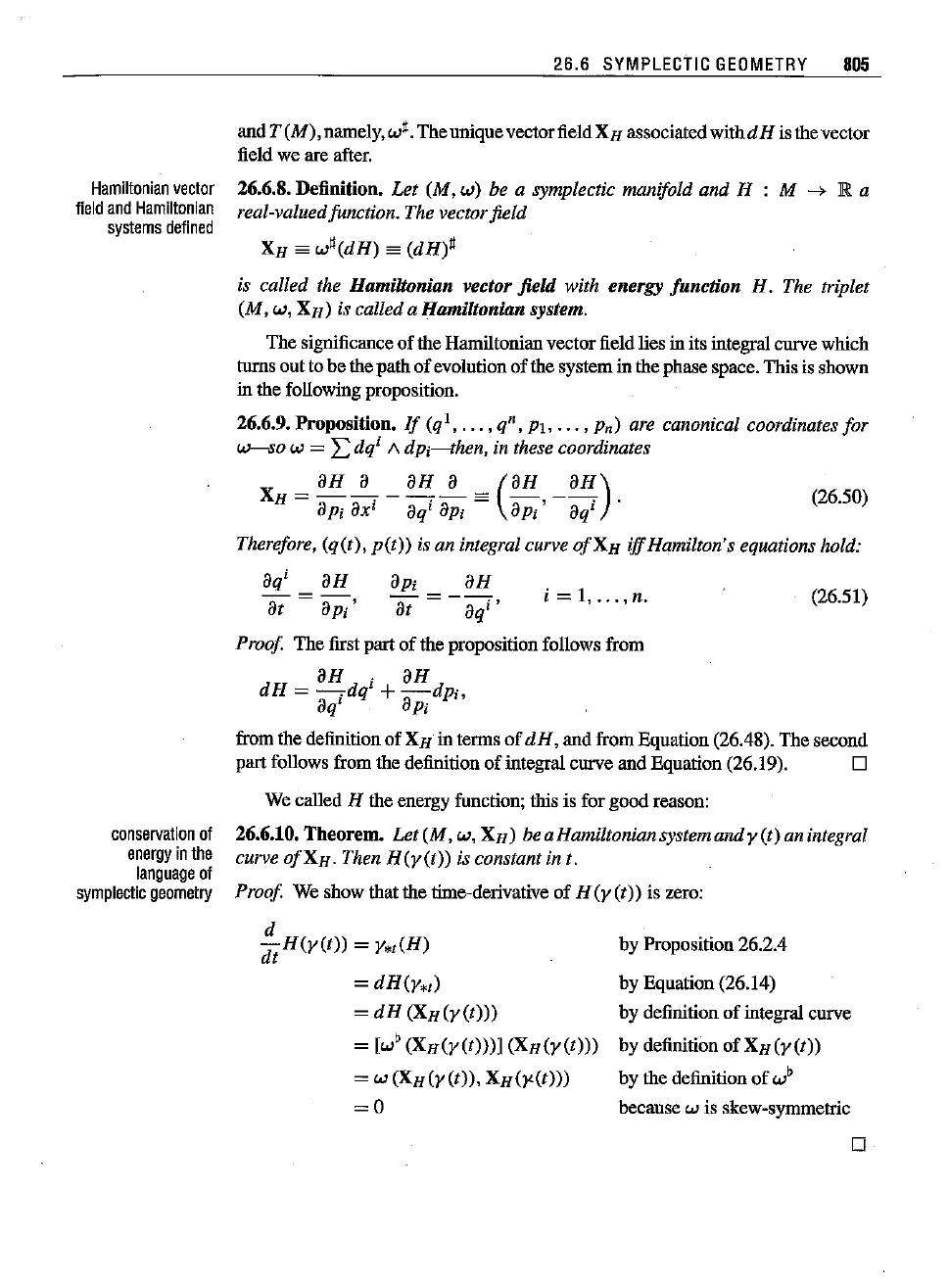
26.6 SYMPLECTIC
GEOMETRY
805
Hamiltonian
vector
field
and
Hamiltonian
systems
defined
andT (M), namely,
w~.
TheuniquevectorfieldXH associated
withdH
isthevector
fieldwe are
after.
26.6.8.Definition. Let (M, w) be a symplectic manifold and H : M --> R a
real-valuedfunction. The vectorfield
XH sa
w~(dH)
es
(dH)~
is called the Hamiltonian vector field with energy function H. The triplet
(M, w, XH) is called a Hamiltonian system.
The significance ofthe Hamiltonianvector fieldlies io its iotegraicurvewhich
turnsout
tobethepath ofevolutionofthe systemio thephasespace.Thisis shown
io the followiogproposition.
26.6.9.Proposition.
If
(ql,
...
,
e".
PI,
...
,
Pn)
are canonical coordinates for
w-so
w = L
dq'
/\
dpi-then,
in these coordinates
XH =
:;
a:
i
-
:;
a~i
==
(:;,
-
:;)
. (26.50)
Therefore, (q(t),
p(t))
is an integral curve
ofXH
iffHamilton's equations hold:
(26.51)i = 1,
..
.
,n.
aqi
aH
api en
at
= aP,'
at
= - aqi '
Proof. The firstpart of the propositionfollowsfrom
en i
aH
dH
=
-.dq
+
-dpi.
aq' api
fromthe definitionof XH io termsof
dH,
andfrom Equation(26.48). Thesecond
part followsfrom the definitionof iotegraicurve and Equation
(26.19). D
conservation
of
energy
in
the
language
of
symplectic
geomelry
Wecalled H the energyfunction;this is for good reason:
26.6.10.Theorem.
Let(M,
w, XH) beaHamiltonian system
andy
(r)anintegral
curve
ofXH.
Then
H(y(t))
is constant in t.
Proof. Weshowthatthe time-derivative of H
(y
(t)) is zero:
d
dt
H(y(t))
= Y.t(H)
=
dH(Y.t)
=
dH
(XH(y(t)))
= [w' (XH(y(t)))]
(XH(y(t)))
= w
(XH(y(t)),
XH(l'(t)))
=0
by Proposition26.2.4
by Equation(26.14)
by definitionof iotegraicurve
by definitionof
XH(y(t))
by the definitionof
w'
becausew is
skew-symmetric
D
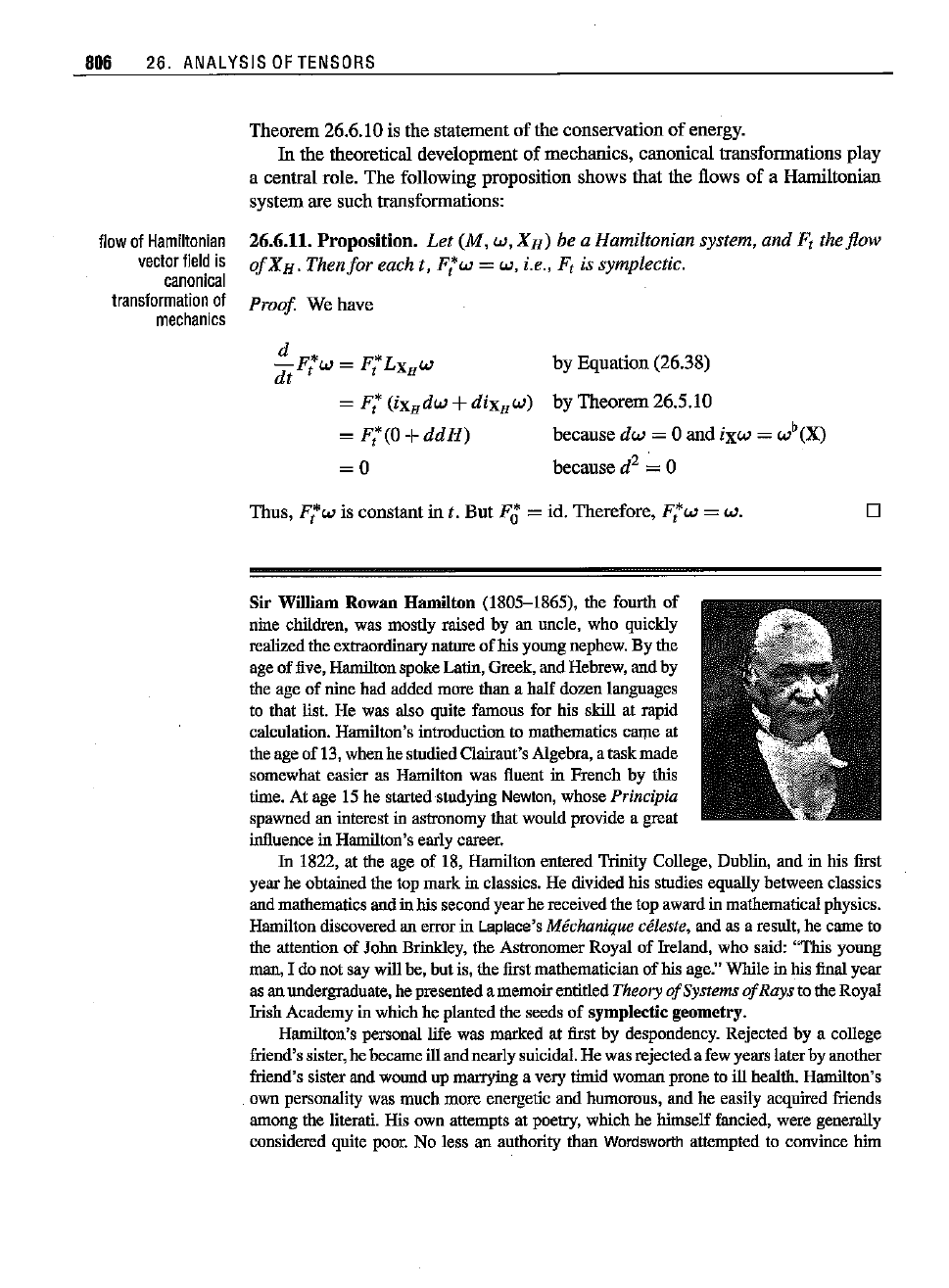
806 26.
ANALYSIS
OF
TENSORS
Theorem
26.6.10
is
the
statement
of
the
conservation
of
energy.
In
the
theoretical
development
of
mechanics,
canonical
transformations
play
a
central
role.
The
following
proposition
shows
that
the
flows
of
a
Hamiltonian
system aresuchtransformations:
flow
of
Hamiltonian
vector
field
is
canonical
transformation of
mechanics
26.6.11.
Proposition.
Let
(M, w, XH) be a Hamiltonian system,
and
F, the flow
OfXH.
Thenfor
each t, F,*w= w, i.e., F, is symplectic.
Proof
We
have
= F
t
'
(ixHdw +dixH
w)
=
F,*(O
+
ddH)
=0
by
Equation
(26.38)
by
Theorem
26.5.10
because
dw
=0
and
ixw
= w
b
(X)
because
d
2
~
0
Thus,
Ft*w
is constantin t. But Fa =id. Therefore,
Ftw
= w.
D
Sir William Rowan Hamilton (1805-1865), the fourth of
nine
children,
was mostly
raised
by an uncle, who
quickly
realized the
extraordinary
nature
of
his young
nephew.
By the
age of five,Hamilton spoke Latin, Greek, and Hebrew, andby
theageof ninehad
added
morethana halfdozen
languages
to that list. He was also quite famous for his skill at rapid
calculation. Hamilton's
introduction
to
mathematics
carne at
the age of 13,when he studied Clairant's Algebra, atask made
somewhat easier as Hamilton was fluent in French by this
time.At age 15he started studying
Newton,
whose Principia
spawnedaninterestin
astronomy
thatwould providea great
influence in
Hamilton's
early
career.
In
1822, at the age of 18, Hamilton entered Trinity College, Dublin, and in his first
yearhe
obtained
thetop
mark
inclassics.He dividedhis
studies
equallybetweenclassics
and
mathematics
andinhis secondyearhereceivedthetop
award
in
mathematical
physics.
Hamilton
discovered an
error
in
Laplace's
Mechanique
celeste, andas a
result,
he cameto
the
attention
of John
Brinkley,
the
Astronomer
Royal of
Ireland,
who
said:
''This
young
man,
I donotsaywill be,butis, the
first
mathematician
of his
age."
Whileinhisfinalyear
asan
undergraduate,
he
presented
a
memoir
entitledTheory
of
Systems
of
Rays
totheRoyal
Irish
Academy
inwhichhe
planted
theseedsof symplectic geometry.
Hamilton's
personal life was
marked
at
first
by
despondency.
Rejected by a college
friend's
sister,
he
became
ill andnearly
suicidal.
Hewas
rejected
afew
years
later
by
another
friend's
sisterandwoundup
marrying
averytimidwoman
prone
toill
health.
Hamilton's
own
personality
wasmuchmore
energetic
and
humorous,
andhe easily
acquired
friends
among
the
literati.
His own
attempts
at
poetry,
whichhe himself
fancied,
were
generally
considered
quite
poor.
No less an
authority
than
Wordsworth
attempted
to convincehim
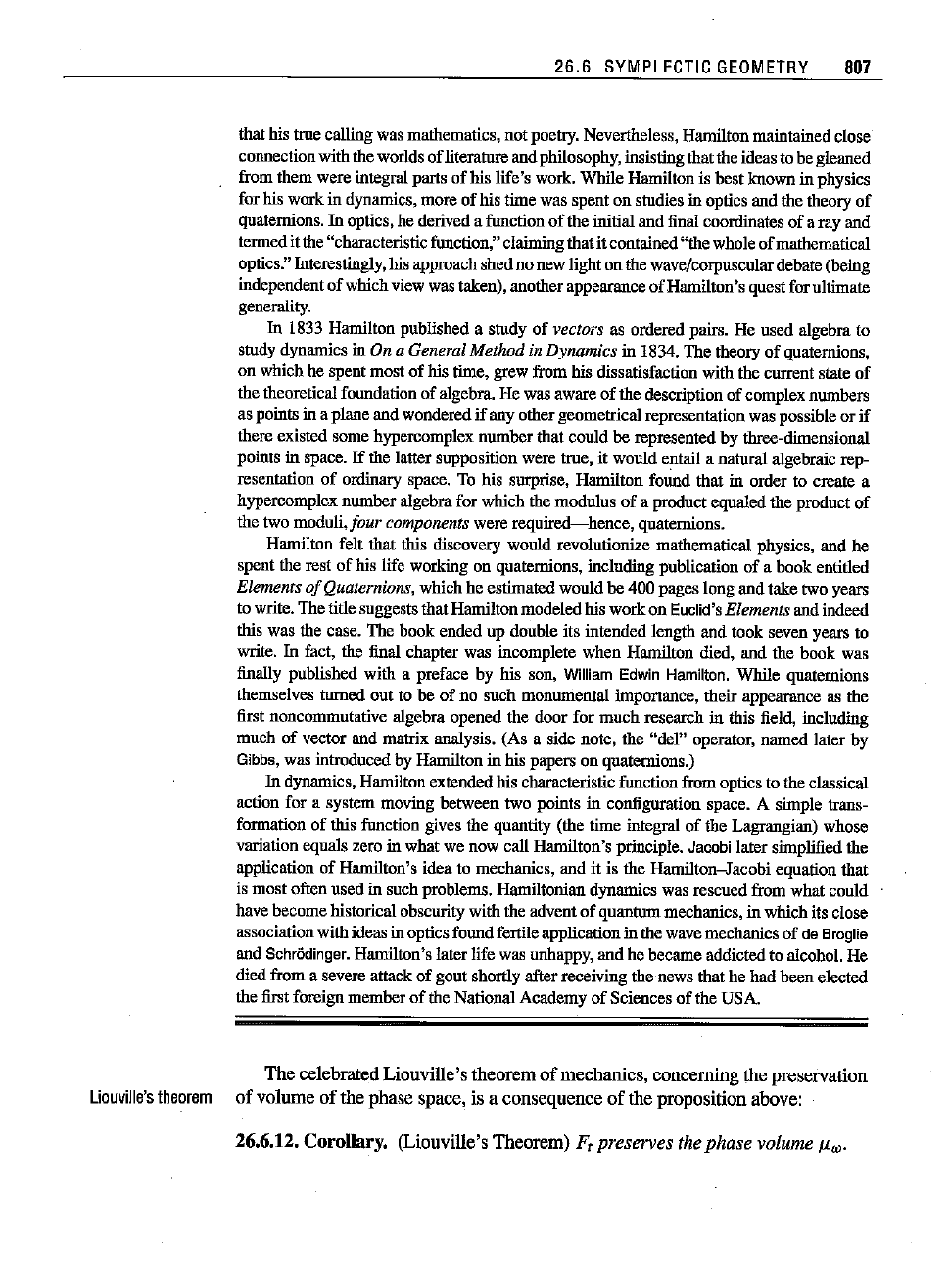
26.6
SYMPLECTIC
GEOMETRY
807
that his truecalling wasmathematics,not poetry. Nevertheless,Hamiltonmaintainedclose
connection
with theworldsofliteratureandphilosophy,insistingthattheideasto begleaned
from them were integral parts
afhis
life's work. While Hamilton is
best
known in physics
for his work
in dynamics, more
of
his time was spent on studies in optics and the theory
of
quaternions.
In
optics, he derived a function
of
the initialand final coordinates
of
a ray and
termed
itthe "characteristicfunction," claiming
that
itcontained
"the
whole
of
mathematical
optics."Interestingly,hisapproachshed nonewlightonthewave/corpusculardebate(being
independentof whichviewwastaken),another appearanceofHamilton's questforultimate
generality.
In 1833 Hamilton published a study
of
vectors as ordered pairs. He used algebra to
study dynamics
in On a General Method in Dynamics in 1834.
The
theory
of
quaternions,
on which he spent
most
of
his time, grew from his dissatisfaction with the current state
of
the theoretical foundation
of
algebra. He was aware
of
the description
of
complexnumbers
as points in a plane and wondered
if
any othergeometrical representation was possible or
if
there existed some hypercomplex
number
that
could
be represented
by
three-dimensional
points in space.
If
the latter supposition were true, it
would
entail a natural algebraic rep-
resentation
of
ordinary space. To his surprise, Hamilton found that in order to create a
hypercomplexnumber algebrafor which the modnlus of a pradncteqnaled the prodnctof
the two
moduli,four
components were
required-hence,
quaremions.
Hamilton felt that this discovery would revolutionize mathematical physics, and he
spent the rest
of
his life working on quaternions, including publication
of
a
book
entitled
Elements
of
Quaternions, which he estimated
would
be 400 pages long and take two years
to write. The titlesuggeststhatHamiltonmodeled his
work
on Euclid'sElements and indeed
this was the case. The hook ended up double its intended length and
took
seven years to
write.
In fact, the final chapter was incomplete
when
Hamilton died, and the
book
was
finally published with a preface by his son,
William
Edwin
Hamilton.
While quaternions
themselves turned out to be
of
no such monumental importance, their appearance as the
first noncommutative algebra opened the door for
much
research in this field, including
much
of
vector and matrix analysis. (As a side note, the "del" operator,
named
later by
Gibbs, was introduced by Hamilton in his papers on quatemions.)
In dynamics, Hamilton extended his characteristic function from optics to the classical
action for a system moving between two points in configuration space. A simple trans-
formation of this functiougives the quantity (the time integral of the Lagrangian) whose
variation equals zero in what we now call Hamilton's principle. Jacobi later simplified the
application
of
Hamilton's idea to mechanics, and it is the Hamilton-Jacobi equation that
is
most
often used in such problems. Hamiltonian dynamics was rescued from what could
have become historical obscurity
with
the advent
of
quantummechanics, in which its close
associationwith ideas
inopticsfound fertile application in the wave mechanics
of
de Broglie
and Schr6dinger. Hamilton's later life was unhappy, and he became addicted to alcohol. He
died from a severe attack
of
gout
shortly afterreceiving the news that he had
been
elected
the first foreign member
of
the National Academy
of
Sciences
of
the USA.
The celebrated Liouville'stheorem
of
mechauics, concerniug
the
preservation
Liouville's
theorem
of
volume
of
the phase space, is a consequence
of
the proposition above:
26.6.12.
Corollary. (Liouville's Theorem) F, preserves the phase volume
I-L",.
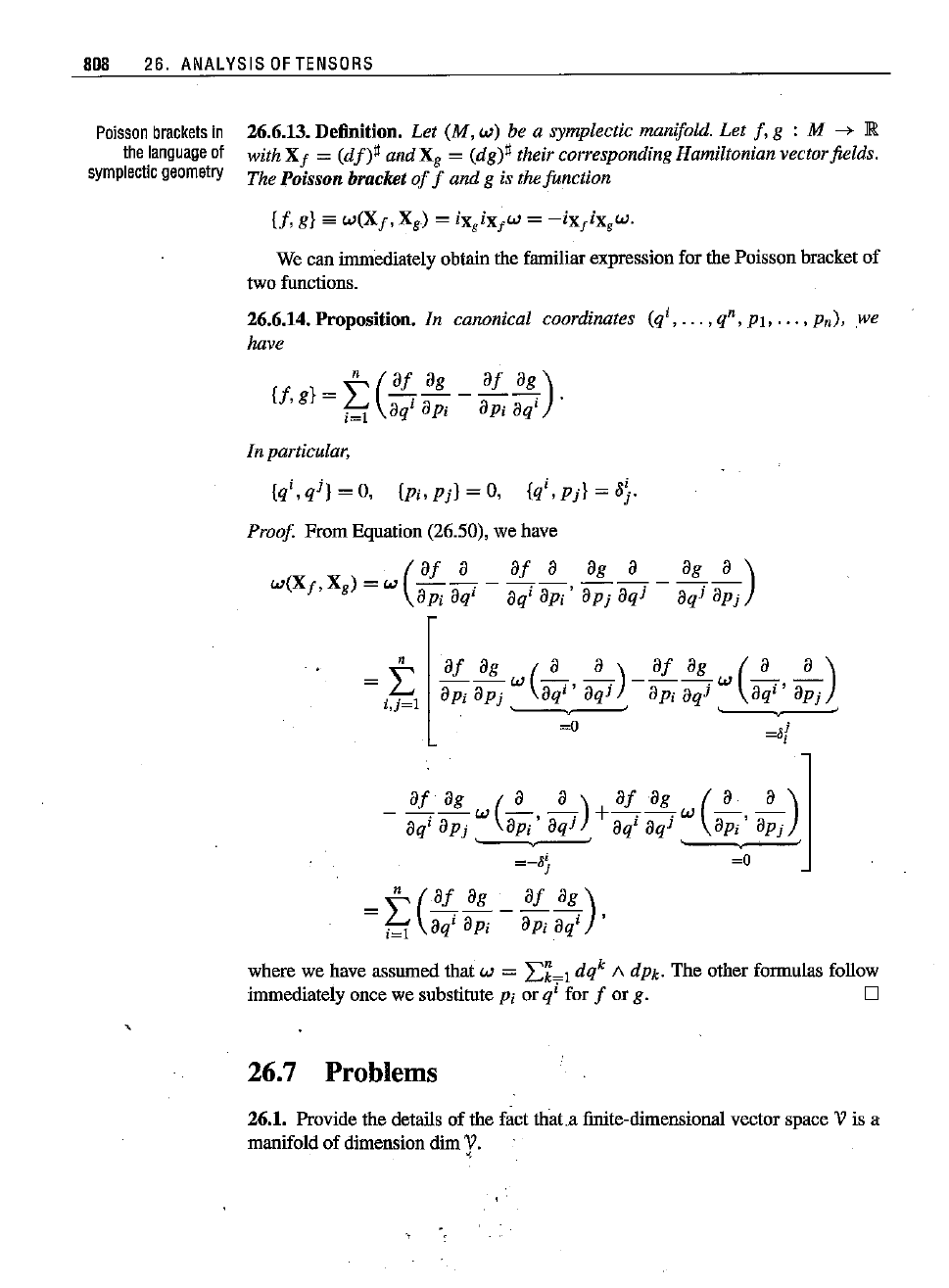
808 26. ANALYSIS
OF
TENSORS
Poisson
brackets
in
the
language
of
symplectic
geometry
26.6.13. Definition. Let (M, w) be a symplectic manifold.
Let
f, g : M
-+
ffi.
with Xj = (df)U
andX
g
=
(dg)U
their corresponding Hamiltonian vectorfields.
The Poisson bracket
of
f and g is thefunction
{f, g}
sa
w(Xj,
Xg) =
ix,ixfw
=
-iXfix,w.
We can immediately obtain the familiar expressionfor the Poisson bracket of
two functions.
26.6.14. Proposition. In canonical coordinates (qi,
...
,q"; Pt,
...
, Pn), we
have
{f
g} =
~
(a
f
~
_
.!L~)
,
tSi
aqi Bp, api aqi .
In particular,
{qi,
qi}
= 0, {Pi, Pi} = 0, {qi, Pi} =
8~.
Proof. From Equation (26.50), we bave
=~f
n
=I:
i,j=l
::i
aa:
i
W
(a:i'
a:i)
-
::i
::i
W
(a:
i'
a;i)
'-----,,--'
'------.-'
=0
-
::i
::i
W
C~i'
a:i)
+
::i
aa:
i
W
(a~i'
a;i)]
'-----,,--'
'------.-'
=-8~
=0
n
(a
f
ag
af
a
g)
=
~
aqi api - api aqi '
where we have assumed that W =
Lk=l
dqk A
dpi,
The other formulas follow
immediately once we substitute
Pi or qi for f or g. D
26.7 Problems
26.1. Provide the details of the fact that.a finite-dimensional vector space V is a
manifold of dimension
dimV.
,

26.7
PROBLEMS
809
26.2. Chooseadifferentcurvey : R
-+
Wwhose tangentat u = Oisstill(ux, Uy)
of Example 26.2.2. For instance, you may choose
y(u)
=
(~(u
+1)2,
~(u
-
1)3).
Show that this curve gives the same relation between partials and unit vectors as
obtained in that example. Can you find another curve doing the same job?
26.3. For every t E 'J"p(M) and every constant function C E FOO(P),show that
t(c) =
O.
Hint: Use both parts
of
Definition 26.2.3 on the two functions f = c
andg=1.
26.4. Find the coordinate vector field at
of
Example 26.2.10.
26.5. Use the procedure of Example 26.2.10 to find a coordinate frame for
S2
corresponding to the stereographic projection charts (See Example 26.1.12).
26.6. Let (xi) and
(yj)
be coordinate systems on a subset U
of
a manifold
M.
Let
Xi and
yi
be the components
of
a vector field with respect to the two coordinate
systems. Show that
yi =
xt
ayi
/ax
j
26.7. Show that if
Vr
: M
-+
N is a local diffeomorphism at P
EM,
then
Vr.P :
'J"
p(M)
-+
'J"",(p)(N)is a vector space isomorphism.
26.8. Let X be a vector field on M and
Vr
:M
-+
N a differentiable map. Then
for any function
f on N,
[Vr.X](f)
is a function on N. Show that
X(f
0
Vr)
=
([Vr.X](f)}
0
Vr.
26.9. Verify that the vector field X =
-ya
x
+
xa
y
has an integral curve through
(xo,
YO)
given by
x =
XQcost
- yosint,
Y =
xosint
+yocost.
26.10. Show that the vector field X = x
2a
x
+
xya
y
has an integral curve through
(xo,
YO)
given by
xo
x(t)=--,
I
-xot
YO
y(t)
=
--.
I-xot
26.11. Let X and Y be vector fields. Show that X 0 Y - X 0 Y is also a vector
field, i.e., it satisfies the derivation property.
26.12. Prove the remaining parts
of
Proposition 26.4.13.
26.13. Suppose that xi are coordinate functions on a subset
of
M and
wand
X are
a l-form and a vector field there. Express
w(X)
in terms
of
component functions
ofwandX.
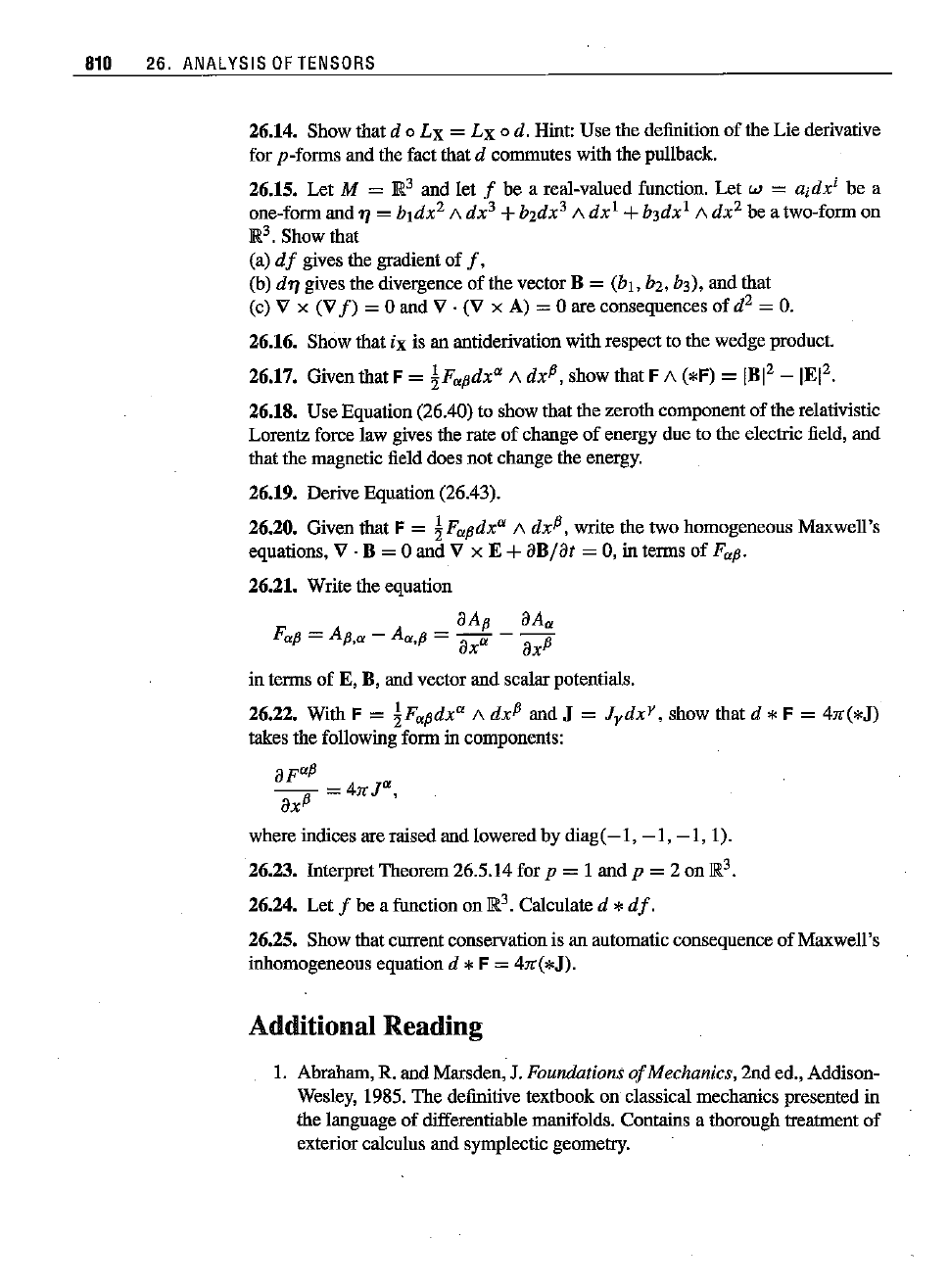
810
26. ANALYSIS
OF
TENSORS
26.14. Show that d 0
Lx
=
Lx
0 d. Hint: Use the definition
of
the Lie derivative
for p-forms and the fact that
d commutes with the pullback.
26.15. Let
M =
]R3
and let f be a real-valued function.
Let
w =
a.dx'
be a
one-form and
Tj = h
1dx
2
A
dx
3
+h2dx3 A
dx
1
+h3dx1 A dx
2
be a two-form on
]R3.
Show that
(a)
df
gives the gradient of
f,
(b)
dn
gives the divergence of the vector B = (hi, h2,h3), and that
(c) V x (V
f)
=0 and V . (V x A) =0 are consequences of d
2
=
O.
26.16. Show that ix: is an antiderivation with respect to the wedge product.
26.17. Given that F = !
Fa~dxa
A
dx~,
show that F A (*F) = IB1
2
-
IEI
2
.
26.18. Use Equation (26.40) to show that the zeroth component of the relativistic
Lorentz force law gives the rate
of
change
of
euergy due to the electric field, and
that the maguetic field does uot change the energy.
26,19. Derive Equation (26.43).
26.20. Giveu that F
= !
Fa~dxa
A
dx~,
write the two homogeneous Maxwell's
equations, V . B
=0 and V x E +
aB/at
= 0, in terms of
Fa~.
26.21. Write the equatiou
aA~
aA
a
Fa~
=
A~,a
-
Aa.~
= ax
a
-
ax~
in terms of E, B, and vector and scalar potentials.
26.22. With F
= !
Fa~dxa
A
dx~
and J =
Jydx
Y
,
show that d * F = 4".(*J)
takes the following form in components:
aFa~
-.-
=4".r,
ax"
where indices are raised and lowered by diag(
-1, -1, -1,
1).
26.23. Interpret Theorem 26.5.14 for
p = 1 and p = 2 on
]R3.
26.24. Let f be a function on]R3. Calculate d *
df.
26.25. Show that current conservation is an automatic consequence of Maxwell's
inhomogeneous equation d * F = 4".(*J).
Additional Reading
1. Abraham, R.and Marsden, J. Foundations
of
Mechanics, 2nd ed., Addison-
Wesley, 1985. The definitive textbook on classical mechanics presented in
the language of differentiable manifolds. Contains a thorough treatment of
exterior calculus and symplectic geometry.

26.7
PROBLEMS
811
2. Bishop, R. and Goldberg, S. TensorAnalysis on Manifolds, Dover, 1980.
3. Bott, R. and
Tu, L. Differential Forms in Algebraic Topology, Sprioger-
Verlag, 1982. Despite its frighteniog title, the first chapter of this book is
actoally a very good iotroduction to tensors.
4. Choquet-Brnhat, Y., DeWitt-Morette, C., and Dillard-Bleick, M. Analysis,
Manifolds, and Physics,
2nd ed., North-Holland, 1982. A two-volume ref-
erence written by mathematical physicists. Excellent for readers already
familiar with the subject and seeking detailed applications io physics.
5. Warner,
F. Foundations
of
Differentiable Manifolds and Lie Groups,
Sprioger-Verlag, 1983. A formal but readable introduction to differentiable
manifolds.

j
j
j
j
j
j
j
j
j
j
j
j
j
j
j
j
j
j
j
j
j
j
j
j
j
j
j
j
j
j
j
j
j
j
j
J
